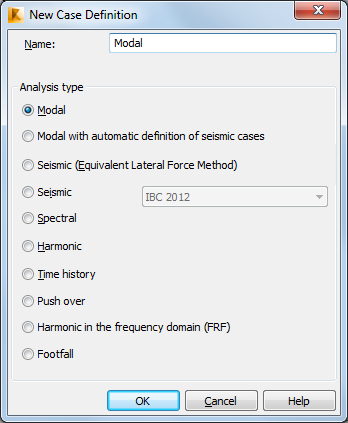Click Add a New Case in the Analysis Types dialog to open The New Case Definition dialog. This defines new dynamic cases within the structure.

The following analysis types can be defined in the dialog:
- Modal
- Spectral
- Seismic (Response Spectrum Method)
- Seismic (Equivalent Lateral Force Method)
- Harmonic
- Time history
- Push Over
- Modal with automatic definition of seismic cases
- Harmonic analysis in the frequency domain (FRF)
- Footfall.
To define an analysis type:
- Specify the case name.
- Select an appropriate analysis type: Modal, Spectral, Seismic (Response Spectrum Method), Seismic (Equivalent Static Method), Harmonic, Time History or Push Over and click OK. For seismic spectral analysis, also select a seismic code.
- Define the analysis parameters in the resulting dialog. When parameters are defined, the appropriate analysis case will be added to the list of load cases.
The seismic analysis according to the equivalent lateral force method is independent from other cases and doesn't require a modal case defined before.
Select Modal with automatic definition of seismic cases option to simultaneously define a modal analysis case (with definition of modal analysis parameters) and a seismic analysis case (with selection of a seismic code and definition of seismic analysis parameters). Select the Modal with automatic definition of seismic cases option to open the Modal Analysis dialog.
Below in the dialog are options representing 2 types of structure analysis:
- Harmonic analysis in the frequency domain (FRF) - A type of analysis which consists in performing sequentially the harmonic analysis for successive frequency values in a selected range.
- Footfall analysis - Analyzes the effect of human footfall loading (interpreted as a harmonic force in a certain frequency interval) on structure vibrations.
If modal analysis of a structure is not defined, dynamic structure analyses (seismic spectral, spectral analysis and time history) are not available. For spectral analysis, seismic analysis and time history analysis, use the results obtained during modal analysis of the structure. The definition of parameters of this analysis has to be preceded by the definition of a modal analysis of a structure. You can define several cases of modal analyses of a structure, each defined by a different set of parameters (differing mass matrices, damping values, and others). Seismic spectral, spectral, time history analyses carry out for the parameter defined for modal analysis, which is located in the list of structure loads.
See also:
Theoretical basis of methods used during structure dynamic analysis
Seismic Analysis Parameters (Response Spectrum Method)
Parameters of Time History Analysis